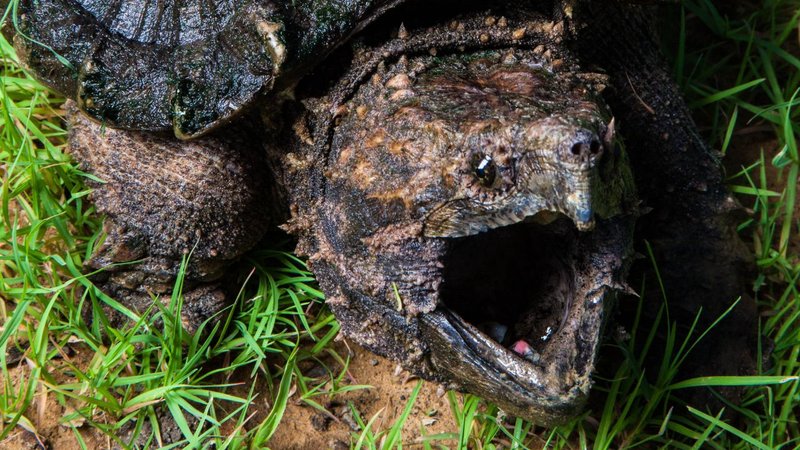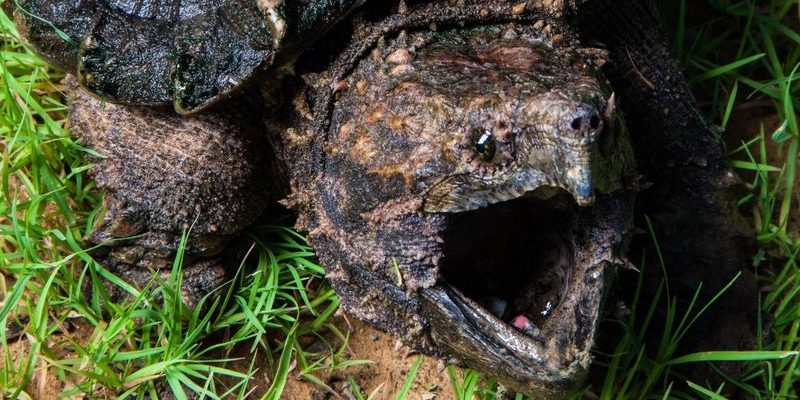
Let’s dive into the world of snapping turtles and explore their habitat. You might be surprised to find out that these creatures aren’t just hiding in the murky waters of your local pond. They have a much wider distribution than you might expect, stretching across various continents and climates. Grab your imaginary snorkel, and let’s take a closer look at where these remarkable turtles can be found around the globe!
North America: The Heart of Snapping Turtles
In North America, snapping turtles are like the neighborhood watch of many water bodies. You can find them in a variety of habitats, including rivers, lakes, ponds, and even swamps. They are particularly common in the eastern United States and parts of Canada. If you’ve ever taken a leisurely stroll near a body of water in these areas, there’s a chance you’ve seen one basking on the shore or lurking just below the surface.
These turtles thrive in both freshwater and brackish environments. They enjoy areas with plenty of vegetation, which provides cover and places for them to hide from predators. Snapping turtles can also adapt to different water temperatures, which makes them quite resilient. In fact, they are often seen scavenging for food—anything from fish and amphibians to the occasional snack of fruit.
As the climate can vary significantly across North America, snapping turtles have developed the ability to survive in temperatures that can range from hot summer days to chilly winters. In colder climates, they go into a kind of hibernation, burrowing into the mud at the bottom of ponds or lakes. When spring rolls around, they slowly emerge to resume their normal activities.
Where Else in the World? Exploring Other Regions
While North America is a significant hub for snapping turtles, they aren’t limited to just this continent. These resilient reptiles can be found in parts of Central and South America, too. For instance, the Common Snapping Turtle is known to inhabit areas in Mexico and even some regions in South America, such as Brazil. However, it’s essential to note that different species of snapping turtles have adapted to various environments across the globe.
In addition to these areas, you’ll find snapping turtles in the Caribbean. They thrive in freshwater ecosystems there, too. Many people don’t realize just how diverse these turtles can be, with their habitats spanning beyond just lakes and streams. In these areas, they often share their environment with numerous other animal species, making for a rich and diverse ecosystem.
It’s not unusual for these turtles to hold significant cultural importance in the regions they inhabit. They often play roles in local folklore and traditions, showcasing the deep connection people have with these fascinating reptiles.
Understanding Their Habitat Preferences
Snapping turtles are quite adaptable, but they do have preferences when it comes to their habitats. They typically favor shallow waters because it allows them to feed and breathe more easily. If you’re looking for them, keep an eye out near vegetation-rich areas or places where there are plenty of rocks and logs. These features provide not only food sources but also hiding spots.
Aside from shallow water, they thrive in environments that offer plenty of cover. Think of places with overhanging trees or thick banks. These spots are perfect for snapping turtles because they can stay hidden from predators while they hunt for food. Additionally, the presence of soft, muddy bottoms is often a plus. This allows them to dig in when they want to stay out of sight.
Honestly, part of the charm of snapping turtles is how they move between different habitats. They’re not just aquatic; they can also make their way onto land, especially during nesting season. A female snapping turtle may travel quite a distance to find the perfect spot to lay her eggs, showcasing their adaptability and determination.
The Impact of Climate on Their Distribution
The climate plays a crucial role in where snapping turtles can be found. In warmer areas, they are active year-round. In contrast, those in colder regions experience a period of dormancy during winter. The temperature changes affect their metabolism and activity levels. If you live in a colder climate, you might notice that snapping turtles are more prevalent in the summer when they emerge for food and breeding.
Interestingly, climate change is having an impact on the habitats of snapping turtles as well. Rising temperatures can alter their breeding patterns and food availability. As water bodies warm, it may promote the growth of certain algae or plants, which can affect the entire local ecosystem.
Here’s the thing: as their habitats change, snapping turtles adjust too. This adaptability is essential for their survival, but it can be a double-edged sword. Ongoing changes in their environment may disrupt their life cycles and the delicate balance they maintain within their ecosystems. It’s important for conservation efforts to consider these factors when assessing the health of snapping turtle populations.
Conservation Efforts and Habitat Protection
Conservation efforts are crucial for maintaining snapping turtle populations and protecting their habitats. As human activities expand, wetlands and aquatic environments face significant threats from pollution, habitat destruction, and global warming. Recognizing the importance of these creatures, many organizations are working to preserve their natural habitats.
One significant effort involves protecting the areas where snapping turtles breed and nest. Public awareness campaigns often encourage people to avoid disturbing nests and educate others about the importance of keeping waterways clean. After all, a clean environment is vital for the survival of not just snapping turtles but numerous other species that share their habitat.
Additionally, wildlife corridors are being established in areas where urban development threatens their migration routes. These corridors allow snapping turtles and other wildlife to travel safely between habitats, helping to ensure a stable population. You might even find local initiatives that promote community engagement in conservation efforts, which can make a big difference for these remarkable creatures.
While snapping turtles may seem tough and tenacious, they rely on healthy ecosystems to thrive. Protecting their habitats ensures they continue to play their important roles in nature.
Discovering Snapping Turtles in Your Area
If you’re curious about snapping turtles and want to catch a glimpse of them in person, figuring out where to look is a great start. As we’ve seen, snapping turtles inhabit various freshwater environments, so your first step is to identify nearby lakes, ponds, rivers, or swamps. Visit these areas during warmer months when the turtles are most active. Morning or late afternoon are often prime times for spotting them basking on the shore.
Don’t forget to research local wildlife regulations. In some areas, it may be illegal to disturb them or their nests. Being respectful is key! If you’re lucky enough to spot a snapping turtle, remember to observe from a distance. These ancient creatures may look fierce, but they’re more likely to retreat into the water than engage with human curiosity.
You might also find guided nature walks or local wildlife programs that focus on snapping turtles. Participating in these activities can deepen your appreciation and understanding of these creatures while supporting conservation efforts.
From the mighty rivers of North America to the serene lakes of Central and South America, snapping turtles inhabit diverse environments worldwide. They serve as vital components of their ecosystems, adapting to changing conditions while reminding us of the intricate connections we share with the natural world. Understanding where snapping turtles are found and how they thrive helps us appreciate their role and the importance of safeguarding their habitats.
As we wrap up this journey, let’s remember that snapping turtles are more than just fascinating creatures; they represent a delicate balance in nature that we must protect. Whether you’re sharing a local pond with them or reading about them from afar, your awareness and efforts can contribute to their conservation. So, the next time you’m out near water, keep an eye out—who knows what wonders you might discover!

